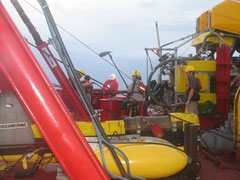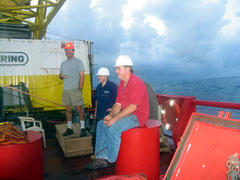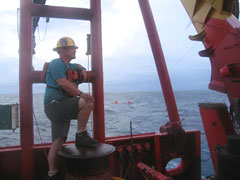

 | |||||||||||||||||
|
|
Journals 2005/2006Susan Holt
May 11, 2005 Everyone on board, including the crew, has been including me in everything that is going on. Last night, one of the crew came into the lounge to take me out to his favorite place on the boat where you can see the bow plowing through the waves. As I looked down about 30 feet, I saw little sparkles in the water. It took me a moment to realize it was bioluminescence of Dinoflagellates, which are living organisms in the Protista Kingdom. Growing up, I used to catch fireflies at night. It looked like thousands of fireflies sparkling in the water. We were supposed to arrive at the site to deploy the airguns, which are used to collect data showing the ocean floor. When we reached the longitude and latitude where the scientists wanted to start, it was about 4:00 a.m. Gregg, the captain, decided it was too dangerous to launch the equipment off the back of the ship in the dark in such rough weather. The decision was made to deploy when the sun rose. At about 5:30 a.m., the scientists, support crew, and the camera crew gathered on the back of the ship, with all the winches, equipment and cables. I have to be careful when taking pictures because the flash interferes with the camera crew, so I don't have pictures of the actual launch. As I described yesterday, the airguns are mounted underneath a steel beam with two large buoys to mark it. It is very dangerous when this instrument is raised by a winch because it swings around. A steel A-frame support this heavy weight and allows the equipment to swing off the back of the ship by tilting out. Everyone involved had to wear safety vests, with buoyancy and reflection tape, steel-toed boots, and hard hats. The camera crew have had only a couple hours of sleep in the last two days, but they were on top of this and every other event that has happened so far. Captain Gregg used a set of headphones to stay in communication with the bridge from the back of the ship. He watched everyone and everything to make sure there were no accidents or problems.
When the airguns were in the water, the streamer with the hydrophones that pick up the data was released. This, too, was rolled out from a winch and then a little recorder, what is called "the bird," was attached to the end of the streamer. This "bird" records the depth of the cable. Typically, the best data is collected when the streamer is at about the same depth as the airguns. David Mosher let me work the winch to release the streamer. This may have been my big chance to become a big T.V. star with my hard hat and steel-toed boots! The ship then slowed to about 4 knots and we towed the airguns and streamer as we headed in a straight line to our first site, where the ROV will be deployed.
When all the equipment was in place, there was a problem, which often happens. Jamie Austin told me it sometimes takes a couple days to a week to get everything going smoothly, but the pressure for this group is to get everything in place quickly so that all the scientists have time to compile as much data as they can in such a limited time. The scientific team is a collaboration of geophysicists, biologists and modeling and visualization groups. The geophysicists are collecting data about what the ocean floor looks like. An expedition by the HMS Scott had gathered data last year about the topography of the ocean floor, but the scientists wanted more information about the composition of the floor. The airguns will give them a view of the layering at some depth. When computers are used, you can actually see where a plate is sliding under another and where sediment is being piled up behind it. My watch started at noon and went until midnight. I am working with Steffen Saustrup and Tim Masterlark. Our job is to record the data by hand in the log about every 15 minutes or when anything changes or looks different. The computers also record this information. It is also typed into a spreadsheet, just to make sure the data is consistent. We recorded our latitude and longitude, depth to the ocean floor, the ship's speed, depth of the equipment, and the time sequence that the airguns were fired, and the time that the data is recorded after the firing. These guns use compressed air, which is what is meant by firing. The air is released in a big bubble every eight seconds. There are actually two guns, each with two chambers that are fired simultaneously.
The last hour and a half of my watch, my job was to monitor the huge air compressors that are responsible for running all the equipment. If these don't work, everything stops, so they are carefully monitored every 15 minutes for pressure, temperature, oil levels, fuel level, and any other problems that might occur. There is an automatic shut down switch to pull if anything goes wrong. I did have ear protection, but when I was done, my ears were ringing because the compressors are so big and loud. At midnight, the next shift came in and I got something to eat before heading off to bed. |
||||||||||||||||



